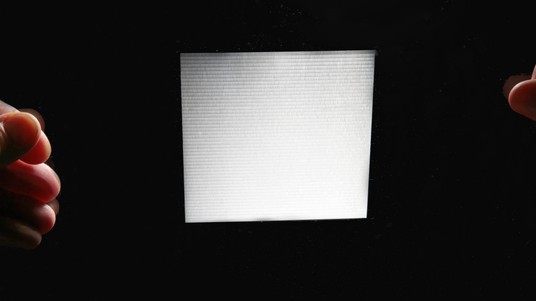An innovative window system earns a European patent

Jing Gong, Andreas Schüler and André Kostro with a prototype of the window-glazing system. © Alain Herzog - 2016 EPFL
A window-glazing system developed by an EPFL team uses micro-mirrors to improve the lighting and visual comfort inside buildings and could also make window blinds obsolete one day. The European Patent Office has just granted the system patent protection.
Are window blinds about to become a thing of the past? They just might, thanks to a ground-breaking window glazing system developed by a team at EPFL's Solar Energy and Building Physics Laboratory (LESO-PB). The innovation’s quality and potential have also now been recognized by the European Patent Office, which has granted it patent protection.
“This patent shows that our approach is original and that our system is unique and merits patent protection,” says Andreas Schüler, a research associate at the LESO-PB. “It’s also reassuring for industry, in the event manufacturers want to use this discovery in the future.” Schüler designed the system together with PhD student Jing Gong and André Kostro, a researcher currently based in Basel.
Laser-cut micro-mirrors
Schüler’s team fitted their windows with a layer of micro-mirrors whose thickness ranges from 0.15 to 0.2 millimeters. This allows the windows to make better use of natural light in the room and reduce both heating and cooling costs in the building. In the summer, the micro-mirrors reflect light back outward, which eliminates direct sunlight and overheating. In the winter, the micro-mirrors redirect light into the building to improve the occupants’ visual comfort.
A high-precision laser is used to cut the micro-mirrors, which are then embedded in a polymer film that is placed between the layers of double-glazed windows. “The challenge was ensuring that the windows remained transparent despite the layer of micro-mirrors,” says Schüler. These windows are meant for building facades that are highly exposed to the sun. The design process took into account the need to keep costs down and enable large-scale production.
Improved visual comfort
This smart-glazing system offers other advantages as well. Preliminary hypotheses developed by the LESO-PB suggest that the system could reduce the thermal load (both heating and cooling) by 10%-20% compared to traditional window glazing. It can improve visual comfort as well by distributing light evenly throughout the room and eliminating sharp contrasts and glare. It also brings in a higher amount of light: up to 150% more light reaches the back of the room and up to three times as much hits the ceiling. Finally, the system was designed to last longer than traditional slatted venetian blinds.
Autonomous system
These windows may one day make blinds obsolete. “When blinds are installed externally, they get dirty very quickly,” says Schüler. “And for some architects, they spoil the look of glass-sided buildings. Yet the disadvantage of installing blinds inside is that they store up heat in the summer. And in both cases, there is a high risk of mechanical damage and wear and tear.” Blinds are associated with another problem too, according to Schüler: no one really knows how to use them most effectively, especially in the case of buildings with a high number of windows. “Our glazing system is based on natural light and geometry, so it works all by itself,” says the researcher.
But will people get used to this new system? The answer will come from the NEST in Dübendorf (Zurich Canton), a futuristic house where the LESO-PB’s innovation will soon be put to the test.
This project was developed with the support of the Swiss Federal Office of Energy (SFOE).


